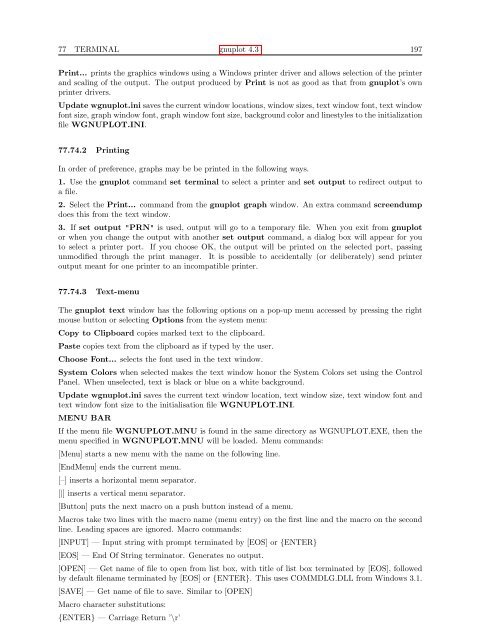gnuplot documentation
gnuplot documentation
gnuplot documentation
You also want an ePaper? Increase the reach of your titles
YUMPU automatically turns print PDFs into web optimized ePapers that Google loves.
77 TERMINAL <strong>gnuplot</strong> 4.3 197<br />
Print... prints the graphics windows using a Windows printer driver and allows selection of the printer<br />
and scaling of the output. The output produced by Print is not as good as that from <strong>gnuplot</strong>’s own<br />
printer drivers.<br />
Update w<strong>gnuplot</strong>.ini saves the current window locations, window sizes, text window font, text window<br />
font size, graph window font, graph window font size, background color and linestyles to the initialization<br />
file WGNUPLOT.INI.<br />
77.74.2 Printing<br />
In order of preference, graphs may be be printed in the following ways.<br />
1. Use the <strong>gnuplot</strong> command set terminal to select a printer and set output to redirect output to<br />
a file.<br />
2. Select the Print... command from the <strong>gnuplot</strong> graph window. An extra command screendump<br />
does this from the text window.<br />
3. If set output "PRN" is used, output will go to a temporary file. When you exit from <strong>gnuplot</strong><br />
or when you change the output with another set output command, a dialog box will appear for you<br />
to select a printer port. If you choose OK, the output will be printed on the selected port, passing<br />
unmodified through the print manager. It is possible to accidentally (or deliberately) send printer<br />
output meant for one printer to an incompatible printer.<br />
77.74.3 Text-menu<br />
The <strong>gnuplot</strong> text window has the following options on a pop-up menu accessed by pressing the right<br />
mouse button or selecting Options from the system menu:<br />
Copy to Clipboard copies marked text to the clipboard.<br />
Paste copies text from the clipboard as if typed by the user.<br />
Choose Font... selects the font used in the text window.<br />
System Colors when selected makes the text window honor the System Colors set using the Control<br />
Panel. When unselected, text is black or blue on a white background.<br />
Update w<strong>gnuplot</strong>.ini saves the current text window location, text window size, text window font and<br />
text window font size to the initialisation file WGNUPLOT.INI.<br />
MENU BAR<br />
If the menu file WGNUPLOT.MNU is found in the same directory as WGNUPLOT.EXE, then the<br />
menu specified in WGNUPLOT.MNU will be loaded. Menu commands:<br />
[Menu] starts a new menu with the name on the following line.<br />
[EndMenu] ends the current menu.<br />
[–] inserts a horizontal menu separator.<br />
[|] inserts a vertical menu separator.<br />
[Button] puts the next macro on a push button instead of a menu.<br />
Macros take two lines with the macro name (menu entry) on the first line and the macro on the second<br />
line. Leading spaces are ignored. Macro commands:<br />
[INPUT] — Input string with prompt terminated by [EOS] or {ENTER}<br />
[EOS] — End Of String terminator. Generates no output.<br />
[OPEN] — Get name of file to open from list box, with title of list box terminated by [EOS], followed<br />
by default filename terminated by [EOS] or {ENTER}. This uses COMMDLG.DLL from Windows 3.1.<br />
[SAVE] — Get name of file to save. Similar to [OPEN]<br />
Macro character substitutions:<br />
{ENTER} — Carriage Return ’\r’

















